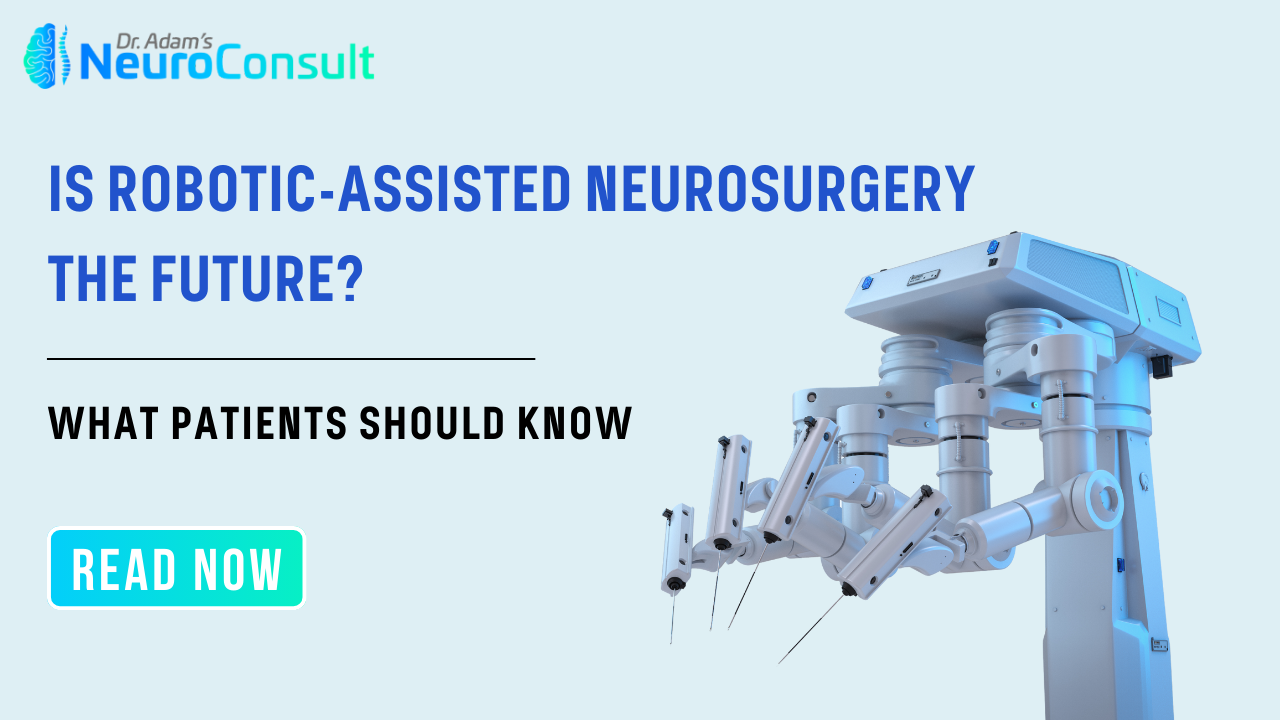
Is Robotic-Assisted Neurosurgery the Future? What Patients Should Know
In recent years, technological advances have transformed various fields of medicine, and neurosurgery is no exception. One of the most promising innovations in this field is robotic-assisted neurosurgery. This advanced technique combines robotics with the expertise of neurosurgeons to enhance precision, reduce recovery times, and potentially improve outcomes for patients. But what exactly is robotic-assisted neurosurgery, and why is it considered the future of brain surgery? Here’s everything patients need to know about this emerging technology.
What is Robotic-Assisted Neurosurgery?
Robotic-assisted neurosurgery is a technique that uses robotic systems to assist surgeons in performing delicate and complex brain and spine surgeries. Unlike traditional neurosurgery, where a surgeon manually controls instruments, robotic-assisted surgery uses a robotic arm to hold and maneuver surgical tools with a high degree of precision. This system operates under the surgeon’s direct control, but the robotics provide enhanced stability, accuracy, and flexibility, particularly in challenging procedures.
Some advanced robotic systems use computer guidance, artificial intelligence (AI), and 3D imaging to help surgeons plan and execute surgery with exceptional precision. These systems are designed to augment a neurosurgeon’s capabilities, not replace them. Surgeons remain in complete control of the procedure but benefit from the added accuracy and control that robotic systems provide.

How Does Robotic-Assisted Neurosurgery Work?
In a robotic-assisted neurosurgery procedure, the neurosurgeon sits at a console with a screen that provides a magnified, high-definition view of the surgical site. The robotic arm, which is positioned over the patient, responds to the surgeon’s hand movements and translates them into precise, controlled movements of the surgical instruments. The console also provides advanced visualization and guidance, allowing surgeons to navigate complex anatomical structures.
The procedure often involves the use of advanced imaging techniques, such as CT scans, MRI, or 3D imaging, to map the surgical area in advance. These images are then integrated with the robotic system, enabling the surgeon to see a detailed “roadmap” of the brain or spine. This guidance can be especially useful for targeting small, hard-to-reach areas, reducing the risk of damage to surrounding tissue.
Advantages of Robotic-Assisted Neurosurgery
- Enhanced Precision: Robotics can perform movements more precisely than human hands alone, allowing surgeons to make tiny, intricate maneuvers essential in neurosurgery.
- Reduced Fatigue for Surgeons: Neurosurgery is often a long, demanding process, and the stability and assistance provided by robotic systems can help reduce surgeon fatigue, leading to potentially better outcomes.
- Minimally Invasive Approach: Many robotic-assisted procedures can be performed using minimally invasive techniques, which generally result in smaller incisions, less blood loss, and reduced scarring.
- Reduced Risk of Complications: By enabling greater control and precision, robotic systems may reduce the likelihood of accidental damage to critical areas.
- Faster Recovery: Minimally invasive robotic surgeries typically involve less trauma to the body, which can lead to shorter hospital stays and faster recovery times for patients.
Types of Procedures Suited for Robotic-Assisted Neurosurgery
-
Tumor Resection
Robotic systems help precisely target and remove tumors in delicate areas of the brain or spinal cord.
-
Spinal Surgery
Robotic assistance can improve accuracy in spinal fusions, vertebral alignment, and other complex spinal procedures.
-
Epilepsy Surgery
Robotic guidance is beneficial for placing electrodes in the brain to locate and treat seizure-causing areas with high accuracy.
-
Deep Brain Stimulation (DBS)
DBS for treating conditions like Parkinson’s disease involves implanting electrodes in the brain, where precision is critical to success.
-
Biopsy Procedures
Robotics can assist in targeting and retrieving small tissue samples from delicate areas, minimizing the risk of collateral damage.
Are There Risks Involved?
While robotic-assisted neurosurgery has many benefits, it is not without risks. Potential risks include:
-
Technical Errors:
Robotic systems rely on complex software and machinery, which could malfunction or encounter issues during a procedure.
-
Training and Experience Required:
Surgeons need specialized training to operate these systems effectively. An inexperienced surgeon may face a learning curve.
-
Cost Considerations:
Robotic systems and the associated maintenance can be costly, potentially leading to higher procedural costs for patients.
-
Availability and Access:
These advanced systems may not be available in all hospitals or regions, limiting patient access to robotic-assisted surgery.

Dr. Adam Kamrudeen
Neurosurgeon in Navi Mumbai
- MBBS, MS – General Surgery,
- MCh – Neuro Surgery
- Brain & Spine Surgeon in Navi Mumbai
Conclusion
Consulting with Dr. Adam Kamrudeen, a skilled neurosurgeon in Navi Mumbai, is crucial if you're dealing with spondylosis. This degenerative condition of the spine can cause significant pain and mobility issues. Dr. Adam Kamrudeen will assess your condition and explain the surgical and non-surgical treatment options available, including minimally invasive techniques to relieve pain and restore function.
Robotic-assisted neurosurgery is reshaping the field by combining surgeon expertise with cutting-edge technology. While the potential benefits are vast, patients should consult healthcare providers to determine the best treatment options. As robotics, AI, and imaging evolve, the future of neurosurgery holds exciting possibilities for enhanced care.
